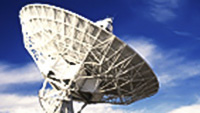Search and order online
Hubble VNR1: 15 Years Special 1 Cosmology
- Video Online only
- Title Hubble VNR1: 15 Years Special 1 Cosmology
- Released: 17/03/2005
- Length 00:13:00
- Language English
- Footage Type Documentary
- Copyright ESA
- Description
On 24 April 2005, the launch of the Hubble Space Telescope (HST) will be 15 years ago. No other telescope in space has had a similar impact on astronomy at large, and the ESA TV Service will release between now and 24 April, a series of three special programmes on the achievements and perspective of HST. These special programmes bring together a large amount of-often not yet released- 3-D graphics of HST results and the phenomena it has been observing. Today's transmission focuses on achievements in cosmology, notably the determination of the age of the Universe and the measurement of the Hubble constant, and new insight into the birth rate of stars in the early universe. The Programme is made of an A-roll (split audio, English) of five minutes plus a B-roll with clean international sound. The video includes:
0:30 Hubble VNR1: birth and evolution of the Universe. The launch of the Hubble Space Telescope 24 April 1990 onboard the Space Shuttle opened the possibility for scientist the look back in time to understand the universe better; to work as a “time machine”. Even if light travels fast through space, it still takes time to pass the enormous distances in space and light from distant starts is therefore very old and can tell us something of the past. Because Hubble is in space it can better detect these faint light sources.
1:33 One of the key questions always asked is How old is the Universe? Hubble was build to answer this fundamental answer. Since the Big Bang the universe has been expanding; the Hubble Constant for this expansion holds the key to determine the age and the size of the universe.
2:19 To understand these elements astronomers look for remote accurate stars. Their stability and variations tell astronomers how far away they are. Hubble is excellent to observe these faint objects, and the best so far. Based on these observation today it is known that the Universe is around 14 billion years old.
3:10 An astonishing discovery Hubble has enabled is that the rate of expansion of the Universe has changed over times. It is found that the Universe is accelerating its expansion.
3:40 Hubble also gave us the most detailed view of the Universe, and what it looked liked when it was much younger. With Hubble is was possible to go deeper and deeper back in time.
4:02 In 1995 Hubble was pointed to the same place in space for 10 days in a row. The first so called Deep Field Observation worked like a photography keeping the shutter open for a few seconds to catch the faint light. The first view of thousands of unknown galaxies, with a great variety in size, forms and colour.
4:42 One of the most stunning results was that stars formed a few billions years after the birth of the Universe was then ten times more stars than today.
4:57 Repeated in 1998, and 2003 and 2004, Hubble’s Deep Field observations have caused a whole revolution in modern astronomy.
5:07 During 15 years of operation, Hubble has enabled astronomers to look further out and further back in space than ever before. It has made astonishing discoveries and will continue to serve astronomers as long as it instruments work probably.
5:42 End









